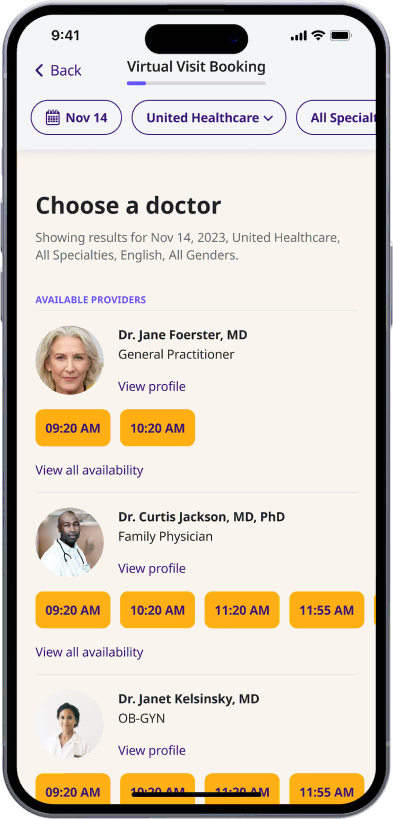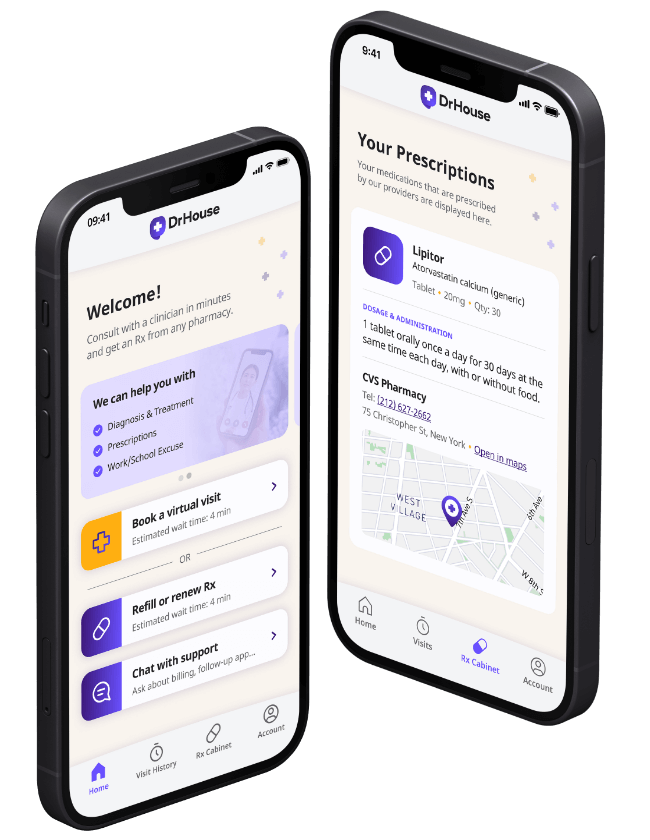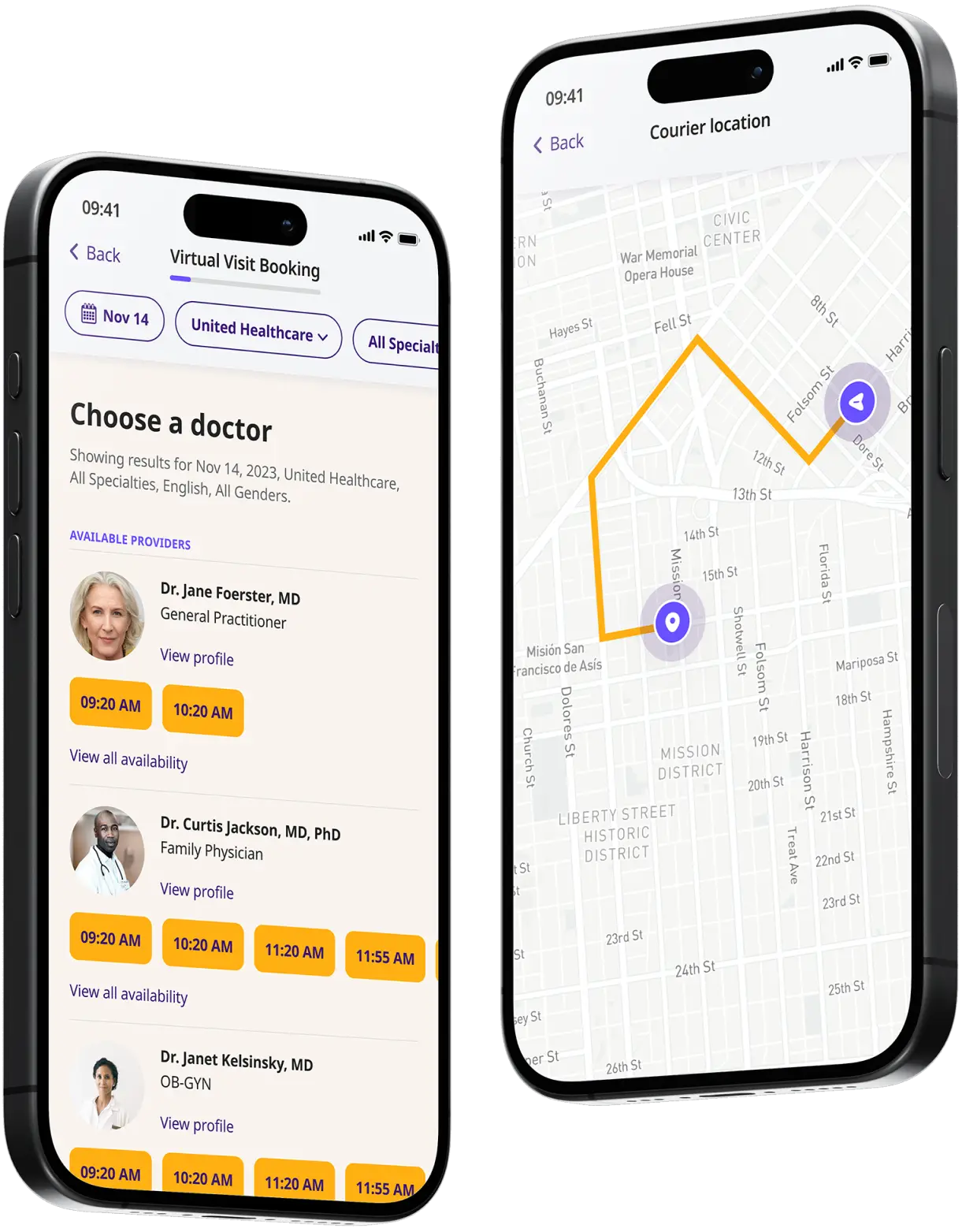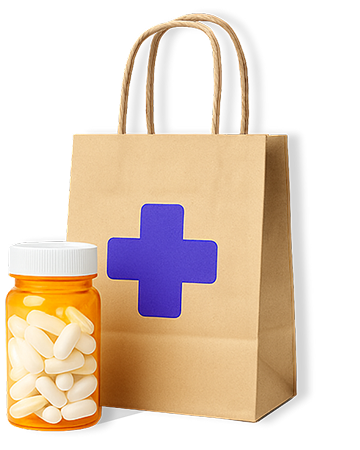Food Poisoning Treatment Online
See an online doctor for food poisoning treatment. Manage nausea, vomiting, and stomach pain with fast and effective care.


Available in 50 states. Insurance accepted.
Fast
virtual visits
24/7 care
assistants
Prescriptions
as needed

24/7 Personal Care
Consult with a physician in 15 minutes, refill an Rx or chat with our care assistants.

Affordable & Convenient
See your cost upfront and get treatment for hundreds of different conditions.

Insurance Accepted
We accept most major insurance plans, making healthcare easy and affordable.
See If Delivery Is Available Near You
Delivery Not Available
Enter your ZIP code to check if prescription delivery is available in your area and how soon your meds could arrive.
How to get started
Choose your doctor, start a virtual visit, and have your prescriptions sent to your preferred pharmacy for pickup — all in just a few easy steps.
Choose a doctor
Choose a physician by availability, specialty, ratings, and more.

Start your video visit
Connect with a doctor in minutes on a secure video call.

Get your prescription
Pick up your meds or have them delivered in as little as an hour.

Available in 50 states. Insurance accepted.
One-Time
Physician Visit
One-time visit with a physician for diagnosis, treatment, Rx, labs, referrals, and doctor’s notes.
Accepted Insurances
See why people turn to DrHouse...
As seen in

Food Poisoning Treatment Online
Food poisoning is an illness caused by consuming contaminated food or drinks. The main culprits behind this condition include bacteria, viruses, and parasites, with some of the most common being Salmonella, E. coli, and norovirus.
Food can become contaminated at any stage during its production, processing, or cooking. Poor hygiene practices, such as inadequate handwashing or improper cooking temperatures, are often to blame.
Symptoms of food poisoning can vary but typically include nausea, vomiting, diarrhea, and abdominal pain. These symptoms can appear within hours of eating the contaminated food, or they might take days to manifest, depending on the pathogen involved.
While most cases are mild and resolve without medical treatment, severe cases, particularly those caused by certain bacteria like E. coli or due to pre-existing health conditions, may require medical attention.
For the vast majority, hydration and rest are sufficient for recovery. However, in cases where symptoms persist or worsen, telehealth services like DrHouse offer a convenient way to consult healthcare professionals who can guide treatment, prescribe medications if necessary, and provide supportive care advice—all from the comfort of your home.
Causes of food poisoning
Food poisoning, a prevalent health issue, is primarily triggered by consuming contaminated food or beverages. The contamination can stem from a variety of sources, often beginning with the improper handling, storage, or preparation of food.
- Biological contaminants: The most common cause of food poisoning is biological contaminants, including bacteria, viruses, and parasites. Bacterial infections, such as those caused by Salmonella, E. coli, and Listeria, are frequent culprits. These bacteria can thrive in raw or undercooked meat, poultry, eggs, and dairy products. Viral infections, like those caused by norovirus and rotavirus, often spread through contaminated water and person-to-person contact. Parasites, although less common, pose significant risks in contaminated water or food.
- Cross-contamination: Cross-contamination is another leading cause of foodborne illness. This occurs when bacteria or other pathogens are transferred from one surface or food item to another, particularly from raw to cooked or ready-to-eat foods. For instance, using the same cutting board for raw chicken and then for vegetables without proper sanitation can lead to contamination.
- Improper cooking and storage: Food that is not cooked to the recommended internal temperature can harbor pathogens that cause illness. Similarly, improper food storage, such as failing to refrigerate perishable items promptly, can allow bacteria to multiply rapidly. The danger zone for bacterial growth is typically between 40°F and 140°F (4°C and 60°C), where food should not be left out for more than two hours.
- Chemical contaminants: Aside from biological factors, chemical contaminants can also lead to food poisoning. These may include pesticides on fruits and vegetables, or cleaning agents that inadvertently come into contact with food. While less common than biological causes, chemical contamination can lead to severe health issues.
- Environmental sources: Contamination can also occur at any point during food production and supply. Water used in farming or processing may contain harmful organisms or chemicals. Moreover, the natural environment of the food, such as polluted areas where fish are harvested, can introduce contaminants.
- Human error: Finally, human error often plays a significant role. Inadequate handwashing, using contaminated utensils, and lack of proper hygiene practices by food handlers can easily spread pathogens.
Symptoms of food ooisoning
The symptoms of food poisoning can vary depending on the type of pathogen involved, but they typically include a range of gastrointestinal disturbances.
Common symptoms include:
- Nausea: A frequent early sign that may or may not lead to vomiting.
- Vomiting: Often occurs to expel contaminated food from the stomach.
- Diarrhea: Can be watery or bloody, depending on the pathogen.
- Abdominal cramps: Pain and discomfort in the stomach area are common.
- Fever: Some cases may involve a mild fever, indicating an immune response.
Symptoms can appear within hours of eating contaminated food, or they might not manifest for several days. Most cases resolve on their own within a few days, but symptoms like persistent high fever, blood in the stool, dehydration, and severe pain may require medical attention.
How to treat food poisoning
Treating food poisoning typically involves managing symptoms and preventing dehydration, as most cases resolve on their own without the need for prescription medication.
Here’s a detailed guide on how to effectively manage and treat food poisoning:
- Hydration: The most critical step in treating food poisoning is to stay hydrated. Vomiting and diarrhea can lead to a significant loss of fluids and electrolytes. It’s important to drink plenty of fluids like water, clear broths, or oral rehydration solutions. Avoid caffeine and alcohol, as they can dehydrate you further.
- Rest: Your body needs energy to fight off the infection, so adequate rest is essential. This helps the immune system to function optimally and recover faster.
- Gradual reintroduction of food: Once vomiting and nausea have ceased, begin to reintroduce bland, easy-to-digest foods slowly. Start with items like toast, crackers, bananas, rice, and applesauce. Avoid fatty, spicy, or dairy foods initially as they can aggravate the digestive system.
- Medications: While most cases don’t require antibiotics, over-the-counter medications can help manage symptoms. For example, anti-nausea medications like meclizine or dimenhydrinate can be used to control nausea and vomiting, and loperamide can help reduce diarrhea. However, always consult with a healthcare provider before taking medication, as some can make symptoms worse, depending on the cause of the food poisoning.
- 5. Avoid Certain Medications:
Avoid taking nonsteroidal anti-inflammatory drugs (NSAIDs) like ibuprofen or aspirin, as they can irritate your stomach. If fever and discomfort are intense, consult a healthcare provider for the best course of action. - Monitor symptoms: Keep a close eye on your symptoms. If you experience signs of severe dehydration (such as dizziness, lightheadedness, or a decrease in urine output), persistent vomiting, blood in the stool or vomit, or high fever (over 101.5°F or 38.6°C), seek medical attention promptly.
- Probiotics: After the initial acute phase of food poisoning, consider taking probiotics to restore the balance of good bacteria in your intestines. Foods like yogurt with active cultures or a probiotic supplement can help.
- Hygiene practices: As you recover, maintain good hygiene practices such as frequent hand washing, especially before handling food and after using the bathroom. This helps prevent the spread of the infection to others.
Prevention of food poisoning
Preventing food poisoning involves implementing several key practices related to hygiene, cooking, and food storage:
- Wash hands and surfaces often: Regularly clean your hands, utensils, and food preparation surfaces before and after handling food, especially raw meat, poultry, seafood, and eggs.
- Cook foods to safe temperatures: Use a food thermometer to ensure meats are cooked to a safe internal temperature to kill harmful bacteria.
- Avoid cross-contamination: Use separate cutting boards and plates for raw meat and ready-to-eat foods. Never place cooked food back on the same plate or cutting board that held raw food.
- Store foods properly: Refrigerate perishable foods within two hours (one hour if the temperature is above 90°F). Keep your refrigerator below 40°F and your freezer at 0°F.
- Use safe water and raw materials: Always use fresh and safe raw materials and ensure water is safe by using it from a clean source or boiling it.
How can DrHouse help you?
As a telehealth platform, DrHouse offers an ideal solution for individuals looking to receive medical advice and treatment for food poisoning from the comfort of their own home.
Our licensed healthcare providers are available 24/7 to provide personalized care and support, including:
- Consult healthcare professionals: Access experienced healthcare providers online who can diagnose symptoms, recommend treatment, and prescribe medication if necessary.
- Prescription services: If a prescription is needed, DrHouse can facilitate getting the necessary medications delivered directly to the patient’s home or a nearby pharmacy.
- Information and guidance: Provide detailed advice on how to manage symptoms and recover from food poisoning, including dietary recommendations and preventative measures.
- Accessible care: Services are accessible from the comfort of home, reducing the need to travel while ill, which is particularly beneficial for those experiencing severe symptoms.
By using DrHouse, individuals can receive timely care and support to effectively manage food poisoning, leading to a quicker recovery and reduced risk of complications. It’s also an excellent option for those who may not have access to traditional healthcare services or prefer the convenience of telemedicine.
So if you suspect you have food poisoning, don’t hesitate to seek medical help through DrHouse for proper diagnosis and treatment.
Related services
Explore more of our services tailored to your needs and discover additional ways we can support your healthcare needs.
Frequently asked questions




